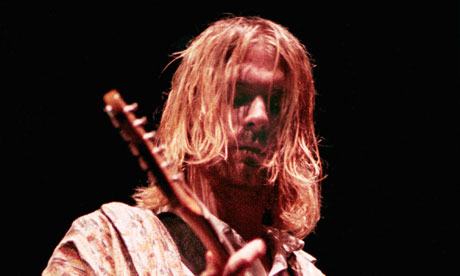 Tragic ends … Kurt Cobain. Photograph: James Crump/WireImage
Tragic ends … Kurt Cobain. Photograph: James Crump/WireImageThe tragic end of Mike Starr, the Alice in Chains bassist who died on Tuesday after a heroin overdose, might look like just another rock death. But for fans of grunge it was yet another reminder of the way heroin had blighted the scene ever since its inception in the mid-80s. After all, Starr wasn't the first grunge star to die early from heroin. In fact, he wasn't even the first member of Alice in Chains to fall prey to it – their singer Layne Staley fatally overdosed in 2002 at the age of 34. There are other grunge deaths of course – from Kurt Cobain to Kristen Pfaff – and the involvement of heroin mirrors the self-hating, nihilistic aspect to the music. But grunge probably isn't the most deadly of genres. After all, its story is more often littered with tales of survival – Stone Temple Pilots' Scott Weiland, Courtney Love, Mark Lanegan and Evan Dando all had their run-ins with the drug, but lived to tell the tale.
Music has long been a risky business, and the deaths often mirror the genre. For instance, the sense of freedom and adventure of early rock'n'roll contrasts with the number of artists who lived fast and died young in car or plane crashes (Buddy Holly, Johnny Kidd, Eddie Cochran). The sexual freedom of disco also had a dark side, as Aids claimed several artists (Sylvester, Dan Hartman and Arthur Russell to name just three). Elsewhere, metal's fondness for theatre seems to have resulted in a series of bizarre deaths – from the surreality of Randy Rhoads being involved in a plane joyride (they hit their own tourbus) to the demonic nature of the Norwegian black metal scene, in which Varg Vikernes murdered his Mayhem bandmate Øystein Aarseth.
Even when they don't die, metallers have a habit of getting ill in style. Take Slayer guitarist Jeff Hanneman, who had to pull out of an Aussie festival because he'd been diagnosed with necrotising fasciitis, a flesh-eating disease. Compare this to, say, Kings of Leon who recently pulled out of gigs citing a "torn bicep" at one, a burnt tourbus at another and – famously – being pooed on by pigeons at another. It's clear that landfill indie might be your best bet if you want a healthy life on the music scene.
You might think singer-songwriters were too well-behaved to encounter death all that often, but you'd be wrong – the grim reaper needs to take some time off there, too. Or, with James Blunt still out there making music, at least show a bit more quality control. Suicide took the lives of many greats: Elliott Smith, Nick Drake, Vic Chesnutt. Again, this seems to reflect the music – introspective, tortured, an expression of rage, but without the deafening volume and tempo to render it truly cathartic.
Perhaps the most health-damaging genre of all, however, is hip-hop, which makes a heroin-scarred career in grunge look more like a seven-day lentil binge at a yoga retreat. For those on the street, rapping about guns and drugs doesn't seem to be a barrier to being taken out by either guns (Biggie, 2Pac, Scott La Rock) or drugs (Pimp C, Ol' Dirty Bastard). But there are other, less documented, ways that hip-hop can mess with your health – especially obesity, which has delivered many a heart attack and claimed the lives of some, such as Puerto Rican rapper Big Pun. Once again, the mood of the music – living dangerously, then greedily – matches the deaths.
Indulgence isn't the only problem for the middle-aged musician who thinks they're past the danger zone, though. Josh Homme recently railed against a US healthcare system that left two of his bandmates in no position to afford cancer treatment – one of whom, Natasha Shneider, died in 2008.
"I've been beating myself up my whole life, but I'm insured, I know the status of my own health," Homme told the Guardian last year. "But even when you're insured, you still get slow-rolled. The bureaucracy of insurance has become its own problem. It's mystifying to me where it's all going."
The list of musicians caught without health insurance includes successful names – Funkadelic guitarist Garry Shider, for example. The moral of this story being that even if you do make it out of rock'n'roll in one piece, what's waiting on the other side could be equally grim.
没有评论:
发表评论